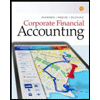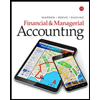
CENGAGENOWV2 FOR WARREN'S FINANCIAL & M
13th Edition
ISBN: 9781305267848
Author: Duchac
Publisher: Cengage Learning
expand_more
expand_more
format_list_bulleted
Concept explainers
Textbook Question
Chapter 4, Problem 1COP
Comprehensive problem 1
Kelly Pitney began her consulting business, Kelly Consulting, on April 1, 2016. The accounting cycle for Kelly Consulting for April, including financial statements, was illustrated in this chapter. During May, Kelly Consulting entered into the following transactions:
| May 3. | Received cash from clients as an advance payment for services to be provided and recorded it as unearned fees, $4,500. |
| 5. | Received cash from clients on account, $2,450. |
| 9. | Paid cash for a newspaper advertisement. $225. |
| 13. | Paid Office Station Co. for part of the debt incurred on April 5, $640. |
| 15. | Recorded services provided on account for the period May 1-15; $9,180. |
| 16. | Paid part-time receptionist for two weeks’ salary including the amount owed on April 30, $750. |
| 17. | Recorded cash from cash clients for fees earned during the period May 1-16, $8,360. |
| Record the following transactions on Page 6 of the journal: | |
| 20. | Purchased supplies on account, $735. |
| 21. | Recorded services provided on account for the period May 16-20, $4,820. |
| 25. | Recorded cash from cash clients for fees earned for the period May 17-23, $7,900. |
| 27. | Received cash from clients on account, $9,520. |
| 28. | Paid part-time receptionist for two weeks’ salary, $750. |
| 30. | Paid telephone bill for May, $260. |
| 31. | Paid electricity bill for May, $810. |
| 31. | Recorded cash from cash clients for fees earned for the period May 26-31, $3,300. |
| 31. | Recorded services provided on account for the remainder of May, $2,650. |
| 31. | Paid dividends, $10,500. |
Instructions
- 1. The chart of accounts for Kelly Consulting is shown in Exhibit 9, and the post-closing
trial balance as of April 30, 2016, is shown in Exhibit 17. For each account in the post-closing trial balance, enter the balance in the appropriate Balance column of a four-column account. Date the balances May 1, 2016, and place a check mark (✓) in the Posting Reference column. Journalize each of the May transactions in a two- column journal starting on Page 5 of the journal and using Kelly Consulting’s chart of accounts. (Do not insert the account numbers in the journal at this time.) - 2. Post the journal to a ledger of four-column accounts.
- 3. Prepare an unadjusted trial balance.
- 4. At the end of May, the following adjustment data were assembled. Analyze and use these data to complete parts (5) and (6).
- a. Insurance expired during May is $275.
- b. Supplies on hand on May 31 are $715.
- c.
Depreciation of office equipment for May is $330. - d. Accrued receptionist salary on May 31 is $325.
- e. Rent expired during May is $1,600.
- f. Unearned fees on May 31 are $3,210.
- 5. (Optional) Enter the unadjusted trial balance on an end-of-period spreadsheet and complete the spreadsheet.
- 6. Journalize and post the
adjusting entries . Record the adjusting entries on Page 7 of the journal. - 7. Prepare an adjusted trial balance.
- 8. Prepare an income statement, a
retained earnings statement, and abalance sheet . - 9. Prepare and
post the closing entries. Record the closing entries on Page 8 of the journal. (Income Summary is account *34 in the chart of accounts.) Indicate closed accounts by inserting a line in both the Balance columns opposite the closing entry.
10. Prepare a post-closing trial balance.
Expert Solution & Answer
Trending nowThis is a popular solution!

Students have asked these similar questions
What was the average collection period? Accounting
what is true answer of this General accounting question
What was the average collection period?
Chapter 4 Solutions
CENGAGENOWV2 FOR WARREN'S FINANCIAL & M
Ch. 4 - Why do some accountants prepare an end-of-period...Ch. 4 - Describe the nature of the assets that compose the...Ch. 4 - Prob. 3DQCh. 4 - What types of accounts are referred to as...Ch. 4 - Why are closing entries required at the end of an...Ch. 4 - Prob. 6DQCh. 4 - What is the purpose of the post-closing trial...Ch. 4 - Prob. 8DQCh. 4 - Prob. 9DQCh. 4 - Recent fiscal years for several well-known...
Ch. 4 - Prob. 4.1APECh. 4 - Flow of accounts into financial statements The...Ch. 4 - Retained earnings statement Marcie Davies owns and...Ch. 4 - Prob. 4.2BPECh. 4 - Prob. 4.3APECh. 4 - Prob. 4.3BPECh. 4 - Closing entries After the accounts have been...Ch. 4 - Closing entries After the accounts have been...Ch. 4 - Accounting cycle From the following list of steps...Ch. 4 - Accounting cycle From the following list of steps...Ch. 4 - Prob. 4.6APECh. 4 - Prob. 4.6BPECh. 4 - Flow of accounts into financial statements The...Ch. 4 - Classifying accounts Balances for each of the...Ch. 4 - Financial statements from the end-of-period...Ch. 4 - Prob. 4.4EXCh. 4 - Income statement The following account balances...Ch. 4 - Prob. 4.6EXCh. 4 - Prob. 4.7EXCh. 4 - Prob. 4.8EXCh. 4 - Retained earnings statement; net loss Selected...Ch. 4 - Classifying assets Identify each of the following...Ch. 4 - Balance sheet classification At the balance sheet...Ch. 4 - Prob. 4.12EXCh. 4 - Prob. 4.13EXCh. 4 - Prob. 4.14EXCh. 4 - Closing entries Prior to its closing, Income...Ch. 4 - Prob. 4.16EXCh. 4 - Closing entries with net loss Mira Services Co....Ch. 4 - Identifying permanent accounts Which of the...Ch. 4 - Post-closing trial balance An accountant prepared...Ch. 4 - Steps in the accounting cycle Rearrange the...Ch. 4 - Working capital and current ratio The following...Ch. 4 - Prob. 4.22EXCh. 4 - Appendix 1 Completing an end-of-period spreadsheet...Ch. 4 - Prob. 4.24EXCh. 4 - Prob. 4.25EXCh. 4 - Completing an end-of-period spreadsheet Alert...Ch. 4 - Adjustment data on an end-of-period spreadsheet...Ch. 4 - Completing an end-of-period spreadsheet Alert...Ch. 4 - Financial statements and closing entries Lamp...Ch. 4 - Financial statements and closing entries Finders...Ch. 4 - T accounts, adjusting entries, financial...Ch. 4 - Ledger accounts, adjusting entries, financial...Ch. 4 - Complete accounting cycle For the past several...Ch. 4 - Financial statements and closing entries Last...Ch. 4 - Financial statements and dosing entries The Gorman...Ch. 4 - T accounts, adjusting entries, financial...Ch. 4 - Prob. 4.4BPRCh. 4 - Complete accounting cycle For the past several...Ch. 4 - Comprehensive problem 1 Kelly Pitney began her...Ch. 4 - Continuing Problem The unadjusted trial balance of...Ch. 4 - Prob. 4.1CPCh. 4 - Financial statements The following is an excerpt...Ch. 4 - Financial statements Assume that you recently...
Knowledge Booster
Learn more about
Need a deep-dive on the concept behind this application? Look no further. Learn more about this topic, accounting and related others by exploring similar questions and additional content below.Similar questions
arrow_back_ios
SEE MORE QUESTIONS
arrow_forward_ios
Recommended textbooks for you
- Principles of Accounting Volume 1AccountingISBN:9781947172685Author:OpenStaxPublisher:OpenStax College
 Financial Accounting: The Impact on Decision Make...AccountingISBN:9781305654174Author:Gary A. Porter, Curtis L. NortonPublisher:Cengage Learning
Financial Accounting: The Impact on Decision Make...AccountingISBN:9781305654174Author:Gary A. Porter, Curtis L. NortonPublisher:Cengage Learning Corporate Financial AccountingAccountingISBN:9781305653535Author:Carl Warren, James M. Reeve, Jonathan DuchacPublisher:Cengage Learning
Corporate Financial AccountingAccountingISBN:9781305653535Author:Carl Warren, James M. Reeve, Jonathan DuchacPublisher:Cengage Learning  Financial & Managerial AccountingAccountingISBN:9781337119207Author:Carl Warren, James M. Reeve, Jonathan DuchacPublisher:Cengage Learning
Financial & Managerial AccountingAccountingISBN:9781337119207Author:Carl Warren, James M. Reeve, Jonathan DuchacPublisher:Cengage Learning Financial AccountingAccountingISBN:9781305088436Author:Carl Warren, Jim Reeve, Jonathan DuchacPublisher:Cengage Learning
Financial AccountingAccountingISBN:9781305088436Author:Carl Warren, Jim Reeve, Jonathan DuchacPublisher:Cengage Learning

Principles of Accounting Volume 1
Accounting
ISBN:9781947172685
Author:OpenStax
Publisher:OpenStax College

Financial Accounting: The Impact on Decision Make...
Accounting
ISBN:9781305654174
Author:Gary A. Porter, Curtis L. Norton
Publisher:Cengage Learning

Corporate Financial Accounting
Accounting
ISBN:9781305653535
Author:Carl Warren, James M. Reeve, Jonathan Duchac
Publisher:Cengage Learning

Financial & Managerial Accounting
Accounting
ISBN:9781337119207
Author:Carl Warren, James M. Reeve, Jonathan Duchac
Publisher:Cengage Learning

Financial Accounting
Accounting
ISBN:9781305088436
Author:Carl Warren, Jim Reeve, Jonathan Duchac
Publisher:Cengage Learning

The ACCOUNTING EQUATION For BEGINNERS; Author: Accounting Stuff;https://www.youtube.com/watch?v=56xscQ4viWE;License: Standard Youtube License